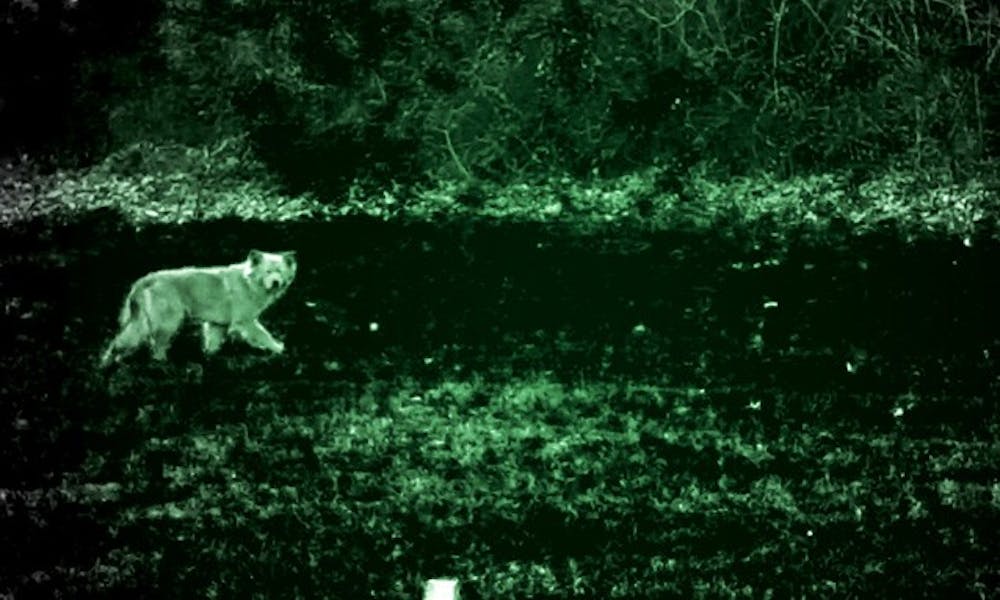In July 2009, Anna Lieb went for an early morning run through the Sarah P. Duke Gardens. The scene was void of human company, and white mist hung in the spaces in her path. Suddenly Lieb, an undergraduate researcher in a Duke laboratory, witnessed a sight she felt she might have dreamt: a large dog-like animal appeared in the fog, followed by three companions.
They ran with intention, she said, in a straight line with a clear leader, directly past her. She wrote in a journal after the incident that the group of canines struck her as “alternately magical and sinister.”
“They sort of noticed me and kept going as though I was beneath their existence or something,” Lieb said “They didn’t even seem like dogs really.”
The ethereal canines Lieb described did not sprout from her imagination, though the appearance of them, passing by in fluid motion, may have seemed mythical in the quiet garden. Sporting pointed ears and bear-like snouts, they regularly travel campus in a pack and share a coat color—reddish gold-brown, their fur grown thick. The largest ones are equal in height to a German shepherd, but bulkier, more muscled in the legs and shoulders. They elude most campus dwellers, but come out sometimes to roam the Duke Forest and West Campus at twilight.
Lieb said the canines behaved like wild animals, and reminded her of a wolfpack.
Red wolves, which were declared extinct in the wild in 1980, have in fact been reintroduced to wildlife refuges in Eastern North Carolina. Duke’s canines, however, do not resemble red wolves, which possess skinny snouts and gracile frames. Several students have described the dogs’ appearance as resembling that of a sleek Chow Chow.
Aaron Sandel, Trinity ’10, and former president of Duke Students for the Protection of Animals, said the creatures are definitely dogs, and that the wild, aloof quality they possess suggests that the members of this current pack were born feral and have never interacted with humans.
“They’ve just acclimated to a wild lifestyle,” he said.
Kate Findlay-Shirras, Trinity ’10, made a film about the dogs for her documentary studies certificate final project. When she began the assignment, she had never seen one of the canines.
“I kind of didn’t believe they existed,” she said.
The red-dog pack, however, has traversed Duke terrain for at least a decade, according to Martha Sue Carraway, a consulting associate professor of medicine, who has resided in a neighborhood off Highway 751 for roughly that time.
“I’ve never had an experience with them where they were hostile or aggressive towards me, but they’re frightening because they are unvaccinated and unsterilized,” said Carraway, who found the pack on her front porch four years ago, cornering her cat. She shooed them and they ran, led by the largest—who stood howling at the end of her driveway.
Durham County Animal Control set a trap in the neighborhood at the time, but the dogs have their own sources of food, Carraway said, and are unlikely to be lured into a food trap.
Carraway said she did speak to Campus Security once about the dogs, when she called 911 after seeing one chase a raccoon up a tree. By the time the police arrived, it had run away. Officers told her they were aware of the dogs, but there was little they could do about them.
“I don’t know what the best solution is,” Carraway said, “but I do have concerns about them being out there for sure.”
Duke University Police Chief John Dailey wrote in an e-mail that he is not aware of any students reporting dangerous encounters with the dogs.
Findlay-Shirras said most people she interviewed described positive encounters with the dogs, though later some friends told her of frightening incidents. When Findlay-Shirras herself first spotted one of the creatures she had spent months learning about, she was ecstatic and told her friend to stop the car they were in.
“I thought it’d be excited to see me too, but it wasn’t really. It kind of stood there,” she said. “The dog I saw did not run up to me and lick my hand and ask for snuggles even though I desperately wanted snuggles back.”
Get The Chronicle straight to your inbox
Signup for our weekly newsletter. Cancel at any time.

